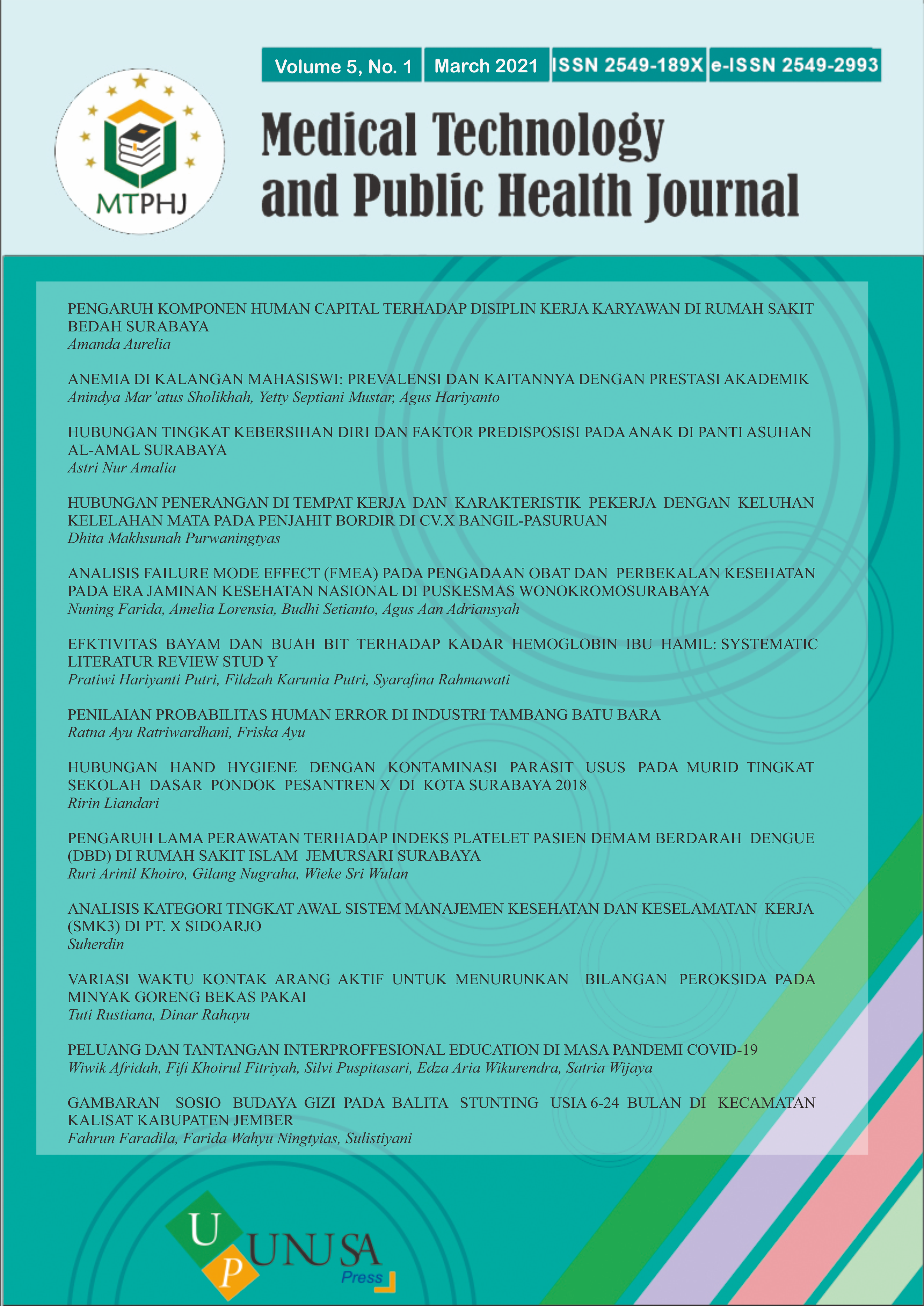HUBUNGAN ANTARA PENERANGAN DI TEMPAT KERJA DAN KARAKTERISTIK PEKERJA DENGAN KELUHAN KELELAHAN MATA PADA PENJAHIT BORDIR DI CV.X BANGIL-PASURUAN
Main Article Content
Abstract
Improper lighting that is not according the standards may result in health problems, one of which is eyestrain, a visual disturbance. Eyestrain is one result of improper lighting that is not according to standards. In addition, the characteristics of workers also play a role in the occurrence of eyestrain. The purpose of this study is to determine the relationship between the lighting in a workplace and the characteristics of workers with complaints of eyestrain in embroidery tailors at CV "X" Bangil, Pasuruan. This study is an observational study with a cross-sectional study design. The research population was all embroidery tailors in CV "X" Bangil, Pasuruan, as many as 122 workers. The research sample was taken using the Simple Random Sampling method, and 55 workers were obtained. The data were collected by measuring the workplace lighting using a luxmeter measuring instrument. The research instrument used were observation sheets and questionnaires. The data analysis was done by using the Fisher's Exact Test. The results of lighting measurements indicate that the intensity of illumination both general and local is still below the Standard Value. The poor quality of lighting is indicated by most workers who experienced glare, shadow disturbances, and improper workplace decorations. The results of the statistical test show that the p value of all variables > α (0.05). There is a significant relationship between the lighting in a workplace and the characteristics of workers with eyestrain. CV "X" needs to schedule a maintenance and cleaning for lights, armatures, wall windows, floors and work desks. In addition, it is necessary to increase the intensity of lighting in the workplace.
Keywords: lighting, worker characteristics, eyestrain
Downloads
Article Details
Copyright (c) 2021 Medical Technology and Public Health Journal

This work is licensed under a Creative Commons Attribution-ShareAlike 4.0 International License.
References
Soeripto M. Higiene Industri. Jakarta: Balai FK Universitas Indonesia; 2008.
Syaifuddin. Anatomi Fisiologi Kurikulum Berbasis Kompetensi untuk Keperawatan dan Kebidanan Edisi 4. Jakarta: EGC; 2011.
Febriana S. Faktor-faktor yang berkaitan dengan Kelelahan Mata pada Karyawan Bagian Administrasi di PT. Indonesia Power UBP Semarang. 2012;1(2). Available from: http://ejournals1.undip.ac.id/index.php/jkm
Hikmatyar. Analisis Faktor-faktor terhadap Kejadian Computer Vision Syndrome (CVS) pada Pekerja Layout Editor di CV.X Tembalang Kota Semarang. 2012; Available from: http://eprints.undip.ac.id/38002/1/4447.pdf
Hiola R. Sistem Pencahayaan pada Pengeraji Karawo Gorontalo. Gorontalo: Lautikabooks; 2000.
Permenkes RI. Peraturan Menteri Kesehatan Republik Indonesia Nomor 70 Tahun 2016 Tentang Kesehatan Lingkungan Kerja Industri. 2016;
Ganong WF. Buku Ajar Fisiologi Kedokteran. Jakarta: EGC; 2009.
Grandjean E. Fitting The Task to The Man. A Text book of Occupational Ergonomics, 4 th edition. London; 1998.
Tarwaka. Ergonomi Industri atau Dasar- Dasar Pengetahuan Ergonomi dan Aplikasi di Tempat Kerja. Surakarta: Harapan Press; 2015.
Anizar. Teknik Keselamatan dan Kesehatan di Industri. Medan: Graha Ilmu; 2009.
Suma’mur P. Higiene Perusahaan dan Kesehatan Kerja (Hiperkes). Jakarta: Sagung Seto; 2014.
Sucipto C. Keselamatan dan Kesehatan Kerja. Yogyakarta: Gosyen Publishing; 2014.
Triwanto S. Stop Merokok. Yogyakarta: Progresif Books; 2007.

